Why does my Panasonic Heat Pump system not heat up instantly?
- DDanielle WilliamsAug 5, 2025
The system may take some time to heat up the water if it starts operating at a cold water temperature.
Why does my Panasonic Heat Pump system not heat up instantly?
The system may take some time to heat up the water if it starts operating at a cold water temperature.
Why is my Panasonic WH-ADC0309K3E5 Heat Pump system hard to heat up?
When the panel and the floor are heated simultaneously, the warm water temperature may decrease, which may reduce the heating ability of the system. Also, when the outdoor air temperature is low or the preset water outlet temperature is low, the system may need a longer time to heat up. Check that the discharge outlet or intake inlet in the outdoor unit is not blocked by any obstacle, such as a pile of snow.
Why does my Panasonic Heat Pump operation start automatically when the timer is not set?
If the timer is not set but the operation starts automatically, it is because the sterilization timer has been set.
Why is my Panasonic Heat Pump making a loud refrigerant noise?
Loud refrigerant noise that continues for several minutes is caused by protection control during de-ice operation when the outdoor ambient temperature is lower than -10 °C.
Why does my Panasonic Heat Pump outdoor unit not operate?
The outdoor unit may not operate because of the protection control of the system when the outdoor temperature is out of the operating range.
Why is the backup heater automatically turned ON in my Panasonic WH-ADC0309K3E5 Heat Pump when it is disabled?
The backup heater automatically turns on due to the protection control of the indoor unit heat exchanger.
Overview of remote controller buttons, display indicators, and navigation keys.
Initial setup steps for language selection and clock/date settings.
Introduction to the Quick Menu for accessing common functions.
Guidance on accessing and navigating the main menu options for users.
Diagram illustrating the indoor and outdoor unit components and connections.
Table detailing operational temperature ranges for heating and cooling.
Safety warnings related to the indoor and outdoor units, including child safety.
Explanation of warning and caution symbols used in the manual.
Precautions regarding power cords, outlets, and wet operation.
Instructions on earthing, disconnecting power, and using RCDs.
Guidelines for cleaning the indoor unit and avoiding hazardous placement.
Precautions for handling the remote controller and ensuring proper drainage.
Warnings about R32 refrigerant flammability and installation requirements.
Procedures for handling refrigerants, piping, and ensuring proper installation.
Description of each button and indicator on the remote controller.
Explanation of how to use the cross key buttons and enter button.
Steps to select the display language for the remote controller.
Procedure for setting the current time and date on the unit.
Final safety check to ensure the outdoor front grille is fixed.
How to display and navigate through the Quick Menu options.
List of functions accessible via the Quick Menu.
How to turn the Domestic Hot Water (DHW) tank heating on or off.
How to operate the heating/cooling system at maximum capacity.
How to select quiet operation levels and set timers.
Procedure for editing and setting quiet timer patterns.
Instructions on how to manually turn on the Force Heater function.
How to set, edit, or copy weekly timer patterns for daily operation.
How to initiate force defrost and reset system errors.
Procedure for locking and unlocking the remote controller.
Setting up to 6 daily operation patterns for the weekly timer.
Setting a holiday period to turn off or lower the system temperature.
Setting quiet operation for a preset period with 6 patterns.
Selecting priority for quiet mode and setting room/tank heaters.
Configuring auto sterilization and Domestic Hot Water modes.
Viewing energy consumption, generation, COP, and system details.
Checking error history and compressor performance data.
Setting remote control number, touch sound, and LCD contrast.
Adjusting backlight duration, intensity, and clock display format.
Procedure for setting the current date and time.
Setting the display language and the unlock password.
Setting up contact names and numbers for installer/service.
Connecting external PCB for additional functions.
Selecting system zones and temperature sensors.
Adjusting heater power and activating water freeze prevention.
Setting DHW capacity and configuring buffer tank connection.
Selecting optional base pan heater and alternative outdoor sensor.
Enabling or disabling bivalent connection for heat sources.
Configuring control patterns for bivalent connection.
Setting target temperatures and delay times for bivalent heat sources.
Setting delay times for DHW heat start in bivalent operation.
Configuring SG ready and smart control patterns for bivalent systems.
Setting electricity prices for different tariffs.
Setting boiler prices and efficiency for cost optimization.
Defining up to four seasons and their start months.
Setting start times and prices for each season's patterns.
Configuring external switches and solar connection.
Setting temperature thresholds for solar connection.
Configuring external error signals, demand control, and SG ready.
Settings for external compressor switch and circulation liquid type.
Setting heat-cool mode and forcing the heater on.
Initiating force defrost and enabling defrost signal.
Configuring pump flowrate, DHW defrost, and heating control.
Setting up external meters for energy generation and consumption.
Enabling or disabling the operation of the electrical anode.
Setting water and outdoor temperatures for heating operation.
Inputting temperature points for heating compensation curve.
Directly setting water temperatures for heating ON/OFF.
Setting water and ambient temperatures for cooling operation.
Setting outdoor temperatures for automatic switching between heat and cool.
Setting maximum floor operation time and tank re-heat temperature.
Configuring sterilization day and time for the tank.
Setting pump speed, pump down, and dry concrete temperature.
Inputting service engineer's name and contact number.
Selecting single or dual remote control setup.
Performing regular checks on indoor/outdoor units and cleaning the water filter.
Ensuring correct water pressure and checking safety relief valves.
Procedures for topping up and venting the circuit system.
User's role in inspection and dealer's responsibilities for maintenance.
Common sounds or behaviors that do not indicate a system malfunction.
Checks to perform before contacting service for operational issues.
List of error codes related to communication and system faults.
Safety warnings for operating the system, especially with network connection.
Information for users on the collection and disposal of old electrical equipment.
Explanation of symbols indicating warnings, flammable refrigerant, and reference to instructions.
Overview of remote controller buttons, display indicators, and navigation keys.
Initial setup steps for language selection and clock/date settings.
Introduction to the Quick Menu for accessing common functions.
Guidance on accessing and navigating the main menu options for users.
Diagram illustrating the indoor and outdoor unit components and connections.
Table detailing operational temperature ranges for heating and cooling.
Safety warnings related to the indoor and outdoor units, including child safety.
Explanation of warning and caution symbols used in the manual.
Precautions regarding power cords, outlets, and wet operation.
Instructions on earthing, disconnecting power, and using RCDs.
Guidelines for cleaning the indoor unit and avoiding hazardous placement.
Precautions for handling the remote controller and ensuring proper drainage.
Warnings about R32 refrigerant flammability and installation requirements.
Procedures for handling refrigerants, piping, and ensuring proper installation.
Description of each button and indicator on the remote controller.
Explanation of how to use the cross key buttons and enter button.
Steps to select the display language for the remote controller.
Procedure for setting the current time and date on the unit.
Final safety check to ensure the outdoor front grille is fixed.
How to display and navigate through the Quick Menu options.
List of functions accessible via the Quick Menu.
How to turn the Domestic Hot Water (DHW) tank heating on or off.
How to operate the heating/cooling system at maximum capacity.
How to select quiet operation levels and set timers.
Procedure for editing and setting quiet timer patterns.
Instructions on how to manually turn on the Force Heater function.
How to set, edit, or copy weekly timer patterns for daily operation.
How to initiate force defrost and reset system errors.
Procedure for locking and unlocking the remote controller.
Setting up to 6 daily operation patterns for the weekly timer.
Setting a holiday period to turn off or lower the system temperature.
Setting quiet operation for a preset period with 6 patterns.
Selecting priority for quiet mode and setting room/tank heaters.
Configuring auto sterilization and Domestic Hot Water modes.
Viewing energy consumption, generation, COP, and system details.
Checking error history and compressor performance data.
Setting remote control number, touch sound, and LCD contrast.
Adjusting backlight duration, intensity, and clock display format.
Procedure for setting the current date and time.
Setting the display language and the unlock password.
Setting up contact names and numbers for installer/service.
Connecting external PCB for additional functions.
Selecting system zones and temperature sensors.
Adjusting heater power and activating water freeze prevention.
Setting DHW capacity and configuring buffer tank connection.
Selecting optional base pan heater and alternative outdoor sensor.
Enabling or disabling bivalent connection for heat sources.
Configuring control patterns for bivalent connection.
Setting target temperatures and delay times for bivalent heat sources.
Setting delay times for DHW heat start in bivalent operation.
Configuring SG ready and smart control patterns for bivalent systems.
Setting electricity prices for different tariffs.
Setting boiler prices and efficiency for cost optimization.
Defining up to four seasons and their start months.
Setting start times and prices for each season's patterns.
Configuring external switches and solar connection.
Setting temperature thresholds for solar connection.
Configuring external error signals, demand control, and SG ready.
Settings for external compressor switch and circulation liquid type.
Setting heat-cool mode and forcing the heater on.
Initiating force defrost and enabling defrost signal.
Configuring pump flowrate, DHW defrost, and heating control.
Setting up external meters for energy generation and consumption.
Enabling or disabling the operation of the electrical anode.
Setting water and outdoor temperatures for heating operation.
Inputting temperature points for heating compensation curve.
Directly setting water temperatures for heating ON/OFF.
Setting water and ambient temperatures for cooling operation.
Setting outdoor temperatures for automatic switching between heat and cool.
Setting maximum floor operation time and tank re-heat temperature.
Configuring sterilization day and time for the tank.
Setting pump speed, pump down, and dry concrete temperature.
Inputting service engineer's name and contact number.
Selecting single or dual remote control setup.
Performing regular checks on indoor/outdoor units and cleaning the water filter.
Ensuring correct water pressure and checking safety relief valves.
Procedures for topping up and venting the circuit system.
User's role in inspection and dealer's responsibilities for maintenance.
Common sounds or behaviors that do not indicate a system malfunction.
Checks to perform before contacting service for operational issues.
List of error codes related to communication and system faults.
Safety warnings for operating the system, especially with network connection.
Information for users on the collection and disposal of old electrical equipment.
Explanation of symbols indicating warnings, flammable refrigerant, and reference to instructions.
| Model | WH-ADC0309K3E5 |
|---|---|
| Category | Heat Pump |
| Type | Air-to-Water |
| Heating Capacity | 9.0 kW |
| Refrigerant | R32 |
| COP at 7/35°C | 4.2 |
| Energy Class Heating | A++ |
| Power Supply | 230V / 1ph / 50Hz |

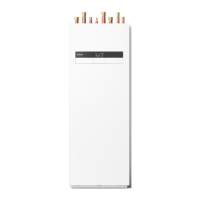

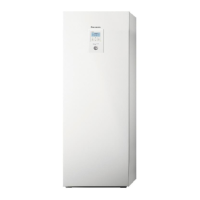
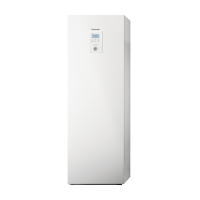


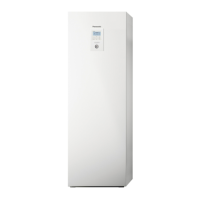
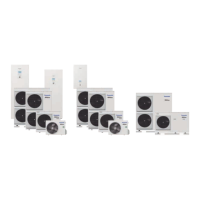

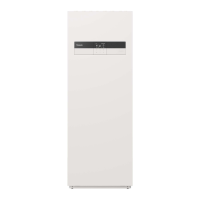
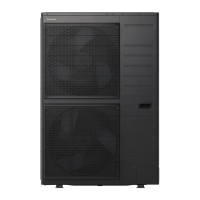
